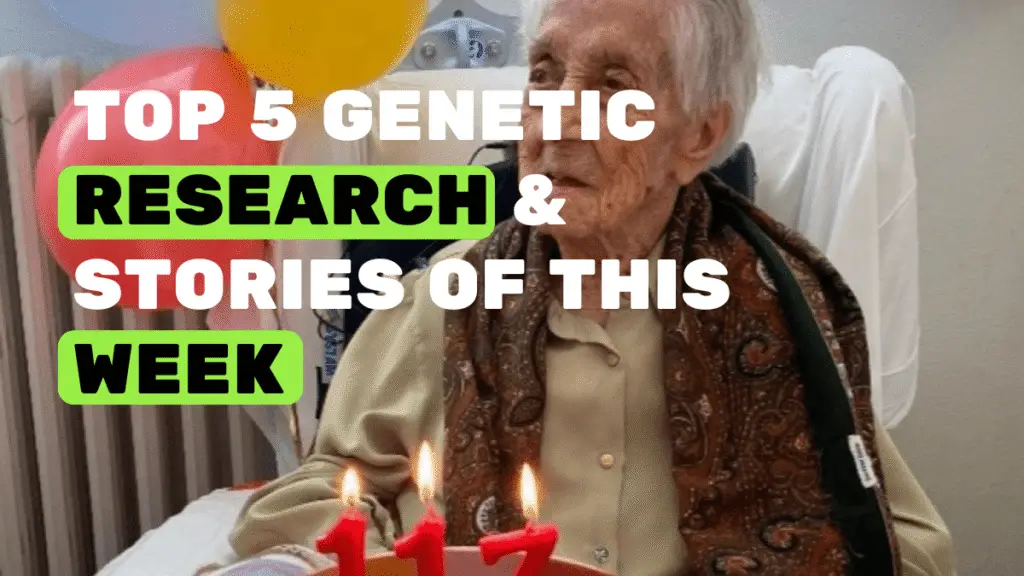Each week, we review the latest genetics research and share the most interesting stories with you. In this issue, we look at genetics research published between 21 to 28 September 2025.
Key Topics:
Yogurt, Genetics and Long Life:
Mariya Branyas Morera is the world’s oldest living person. Mariya died at the age of 117 in the year 2023. A new study published in Cell Reports Medicine analysed her genetics and lifestyle.
The study revealed her remarkable lifespan was shaped by both unique genetic variants that offered her protection against diseases and her healthy habits, including a Mediterranean diet rich in olive oil, fish oil, and three yoghurts a day.
Using blood, saliva, urine, and stool samples, Dr Manel Esteller and his team at the University of Barcelona showed that living this long without any medical ailment was not just a matter of luck or lifestyle, but her unique genetic profile played a big role too.
Scientists showed that she carried rare protective variants across multiple gene pathways. These variants were associated with immune resilience, cardiovascular and neural protection, mitochondrial health, and inflammation control.
Additionally, she also had surprisingly short telomeres; normally, short telomeres are a sign of early ageing, but in her case, scientists speculate that short telomeres may have served as a protective barrier by limiting uncontrolled cell division.
The most interesting finding of this study was that her epigenetic clock based on DNA methylation showed that her biological age was significantly lower than her chronological age. This difference suggests that her genome maintained a younger regulatory state.
Another observation was that she had a healthy gut microbiome. And as we already know, a healthy gut microbiome can be very beneficial for our genetic health.
You can read the complete story here: She lived to be the world’s oldest person, a new study credits genetic variants- and may be her yogurt habit.
Genetic Evaluation and Breeding Index:
With the Advanced genetic tools, New Zealand’s Informing New Zealand Beef (INZB) programme, supported by Beef and Lamb New Zealand and the Ministry for Primary Industries, is collectively reshaping the future of the beef industry.
The study examines the data from nine years of the Beef Progeny Test, which reveals that growth traits in cattle are strongly interconnected. It is observed that 18-month weight shows a very high genetic correlation with mature cow size.
This means that animals that grow rapidly and reach heavy weight at 18 months of age will inevitably grow as larger adult cows, which is good for meat production, but large cows will cost more in terms of feed.
The challenge here is that farmers would definitely want heavier and faster-growing cattle for profits, but they also want moderate-sized cows so that they eat less and are cost-efficient.
Now, to balance out this problem, INZB is developing genetic evaluations and breeding indexes. The goal here is to make beef farming more efficient, profitable and sustainable.
You can read the complete story here: How Genetics influences calf growth and mature cow size in NZ.
The benefits of fish oil for Colon Cancer depend on genetics:
19 million people in the U.S. consume fish oil supplements for protection against some chronic diseases, like cancer.
Recent research by scientists from the University of Michigan and Anderson Cancer Centre suggests that the cancer-fighting benefits of fish oil depend on a single gene – ALOX15.
The ALOX15 gene is essential for omega-3 fatty acids in fish oil to reduce the risk of colon cancer. The study reveals that without this gene, fish oil could actually increase and fuel the development of colon cancer.
The present study on the model organism also suggests that fish oil isn’t beneficial for everyone, until they have this gene variant. Consulting a doctor before taking any supplement is highly recommended.
More research is required to explore the role of the ALOX15 gene and the omega-3 supplement against cancer.
Read the complete story here: Genetics plays a role in fish oil’s effects on cancer risk.
Life expectancy and death rate vary between the two disease groups:
Sickle cell anaemia and cystic fibrosis are both life-threatening genetic conditions. A new study reveals that life expectancy improvements, especially in Americans, are not equal in both of these diseases over time.
For instance, people with cystic fibrosis are living much longer than before. The death rates are going down in most age groups due to better treatment and care. And the life expectancy has increased from 31 years to 48 years, that is, around 15 years.
While people suffering from sickle cell disease are not seeing much improvement. Life expectancy doesn’t improve substantially while death rates are still high across many age groups.
Meaning, these two factors vary among the sickle cell anemia and cystic fibrosis disease group patients.
Explore the complete story from here: Individuals with these two genetic conditions are seeing increased, but unequal life expectancies.
Micronutrients and our genome:
Many factors help evolve our genome; micronutrients are one among those factors. The present study showed that oil and diet have silently shaped the genetic adaptations over time.
Scientists discovered evidence of positive selection for genes linked to micronutrient (calcium, magnesium, selenium, iron, zinc, and iodine) metabolism, uptake and regulation.
In other words, genes must adapt depending on the presence or absence of the micronutrient. For instance, populations that live in iodine-deficient areas, like the Mbuti in Central Africa and the Maya in Central America, have been shown to have adaptations in iodine-related genes.
This study demonstrated that micronutrient deficiency and associated disorders depend on the presence or absence of a micronutrient in the soil and a gene variant shaped by the interaction.
You can explore the complete story here: Soil to genes: how human genetics adapts to micronutrient deficiencies and excess.
Wrapping up:
That’s all for this week’s genetic discoveries.
This is just a sneak peek into the world around genetics, the latest research and findings and how it affects the world. Read the previous edition of this series on our blog and subscribe to Genetic Education.
Note that the links for each original article are already provided; you can click and read the original article as well.
I hope that you enjoyed reading this. Stay tuned for next week.


